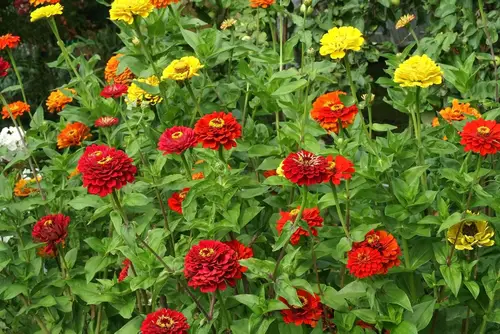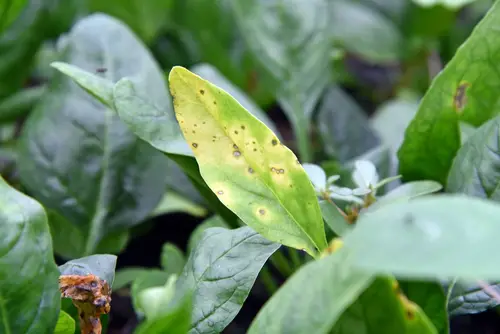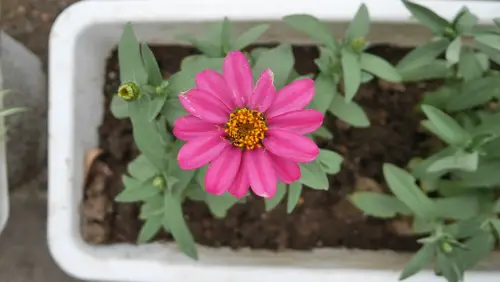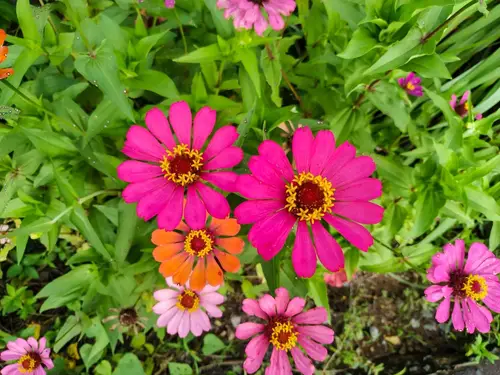Zinnias are beautiful, easy-to-grow flowers that add a pop of color to any garden. However, if you notice your zinnia leaves turning brown, it can be concerning and frustrating.
Brown leaves on zinnias can be caused by a variety of factors, including disease, pests, and environmental conditions. This article will explore the reasons behind brown leaves on zinnias and provide tips on how to prevent and treat this issue.
Understanding zinnias and their needs is an essential first step in identifying why your zinnia leaves are turning brown. Zinnias are heat-tolerant and prefer full sun, well-draining soil, and consistent watering.
Overwatering or underwatering can cause stress to the plant and lead to brown leaves. Additionally, zinnias are susceptible to various diseases and pests, which can cause brown leaves and other issues.
Identifying the cause of brown leaves in zinnias is crucial in determining the appropriate treatment method. Common diseases in zinnias include Alternaria leaf spot, bacterial leaf spot, and powdery mildew.
Insect infestations such as spider mites and aphids can also cause brown leaves. Environmental conditions like frost or extreme heat can also stress the plant and cause brown leaves. With the right knowledge and care, you can prevent and treat brown leaves on your zinnias.
Key Takeaways
- Brown leaves on zinnias can be caused by a variety of factors, including disease, pests, and environmental conditions.
- Understanding zinnias and their needs is crucial in identifying the cause of brown leaves.
- Identifying the cause of brown leaves is essential in determining the appropriate treatment method.
More posts on this category:
Understanding Zinnias and Their Needs
Zinnias are annual plants that belong to the daisy family. They are easy to grow, and their bright, colorful flowers make them a popular choice for gardeners. However, like all plants, zinnias have specific needs that must be met for them to thrive.
1. Sunlight

Zinnias require full sun to grow and bloom. They need at least six hours of direct sunlight each day. If they don’t get enough sun, they may become leggy and produce fewer flowers.
2. Temperature
Zinnias prefer warm temperatures. They grow best when the temperature is between 75 and 85 degrees Fahrenheit during the day and around 60 degrees Fahrenheit at night. If the temperature drops below 50 degrees Fahrenheit, the plants may stop growing or die.
3. Nutrients
Zinnias need nutrients to grow and produce flowers. They require a balanced fertilizer with equal amounts of nitrogen, phosphorus, and potassium. A lack of nutrients can cause the leaves to turn yellow or brown.
4. Water
Zinnias need regular watering to stay healthy. They prefer well-draining soil that is moist but not waterlogged. Overwatering can cause the roots to rot, while underwatering can cause the leaves to wilt and turn brown.
5. Watering Schedule
It’s essential to establish a watering schedule for zinnias. They should be watered deeply once a week, or more often if the soil is dry. Watering in the morning is best, as it allows the leaves to dry before the sun goes down, reducing the risk of fungal diseases.
Identifying Brown Leaves in Zinnias
Zinnias are a popular choice for gardeners due to their vibrant colors and low maintenance. However, one common problem that gardeners face is brown leaves in zinnias.
Brown leaves can be caused by a variety of factors, including fungal infections, pests, and environmental stressors. Identifying the cause of brown leaves is the first step in treating the problem.
Brown Spots
If you notice small brown spots on the leaves of your zinnias, it could be a sign of a fungal infection. Alternaria leaf spot is a common fungal disease that affects zinnias, as well as other plants. The spots may have gray-white centers and reddish-brown patches around the edges. Over time, the spots can merge and cause the entire leaf to turn brown.
Dark Brown Leaves

If the leaves of your zinnias are turning dark brown, it could be a sign of environmental stress. Zinnias prefer full sun and well-drained soil. If they are planted in a shady area or in soil that is too wet, they may develop dark brown leaves. Additionally, overwatering can lead to root rot, which can cause the leaves to turn brown and wilt.
Holes in Leaves
If the leaves of your zinnias have holes in them, it could be a sign of pest damage. Common pests that feed on zinnias include aphids, spider mites, and caterpillars. Look for the pests on the underside of the leaves. You can treat pest infestations with insecticidal soap or neem oil.
Leaf Spots
Leaf spots are another common sign of fungal infections in zinnias. The spots may be reddish-brown and have a yellow halo around them. As the infection progresses, the spots can merge and cause the entire leaf to turn brown.
Fungal infections thrive in moist environments, so it’s important to water your zinnias at the base of the plant and avoid getting the leaves wet.
Common Diseases in Zinnias
Zinnias are beautiful flowers that come in various colors and sizes. However, they are prone to several diseases that can cause the leaves to turn brown and eventually lead to the death of the plant. Here are some of the most common diseases that affect zinnias:
1. Alternaria Leaf Spot
Alternaria leaf spot is a fungal disease that affects several plants, including zinnias. It appears as brown or black spots on the leaves and can spread quickly under warm and humid conditions.
The disease can weaken the plant and cause the leaves to wilt and die. To prevent the spread of the disease, it is essential to remove and destroy the infected leaves and stems. Fungicides can also be used to control the disease.
2. Powdery Mildew
Powdery mildew is a fungal disease that appears as a white or gray powdery coating on the leaves, stems, and flowers of the zinnia plant. The disease can cause the leaves to turn brown and eventually die.
It is prevalent in warm and humid conditions and can spread quickly. To prevent the disease, it is essential to maintain good air circulation, avoid overhead watering, and remove and destroy the infected leaves and stems.
3. Bacterial Leaf Spot

Bacterial leaf spot is a disease caused by bacteria that affect several plants, including zinnias. It appears as water-soaked lesions on the leaves and can cause the leaves to turn brown and eventually die.
The disease can spread quickly under warm and humid conditions. To prevent the spread of the disease, it is essential to remove and destroy the infected leaves and stems. Copper-based fungicides can also be used to control the disease.
4. Aster Yellows
Aster yellows is a disease caused by a phytoplasma that affects several plants, including zinnias. It appears as yellowing and stunting of the leaves and can cause the leaves to turn brown and eventually die.
The disease can spread quickly under warm and humid conditions. There is no cure for the disease, and infected plants should be removed and destroyed to prevent the spread of the disease.
Impact of Weather and Environmental Conditions
Zinnias are sensitive to weather and environmental conditions, and their leaves can turn brown due to a variety of factors. Here are some of the most common weather and environmental conditions that can impact zinnias:
1. Overwatering
Overwatering can lead to waterlogged conditions, which can cause the roots to rot and the leaves to turn brown. It is important to water zinnias only when the soil is dry to the touch.
2. Heat and Direct Sunlight
Zinnias prefer warm temperatures, but too much heat and direct sunlight can cause the leaves to wilt and turn brown. It is best to plant zinnias in a location that receives partial shade during the hottest part of the day.
3. Lack of Water and Drought Conditions
Zinnias need consistent moisture to thrive, and a lack of water can cause the leaves to wilt and turn brown. During drought conditions, it is important to water zinnias deeply and regularly to keep the soil moist.
4. Humidity
High humidity can create ideal conditions for fungal diseases that can cause the leaves to turn brown. It is important to ensure good air circulation around zinnias and to avoid getting the leaves wet when watering.
5. Frost and Freezing Temperatures
Zinnias are annuals and are not frost-tolerant. Exposure to frost or freezing temperatures can cause severe damage to the plant, including brown and dying leaves. It is important to plant zinnias after the last frost date in your area and to cover them with a frost blanket if frost is expected.
Insect Infestation and Zinnias

Zinnias are prone to insect infestations, which can cause their leaves to turn brown. Some of the common pests that can affect zinnias include aphids, spider mites, and thrips. These insects feed on the sap of the plant, which can cause the leaves to wilt and turn brown.
Ants are also commonly found on zinnias, but they do not directly cause the leaves to turn brown. Instead, they are attracted to the sweet sap that is produced by the plant. If you notice a lot of ants on your zinnias, it could be a sign that they are infested with aphids or other sap-sucking pests.
To prevent insect infestations, it is important to keep your zinnias healthy and well-maintained. This includes watering them regularly, providing them with enough sunlight, and fertilizing them as needed. You can also use insecticidal soaps or oils to control pests, but be sure to follow the instructions carefully to avoid damaging the plant.
In addition to insect infestations, zinnias can also be affected by diseases such as bacterial leaf spot and powdery mildew. These diseases can cause the leaves to turn brown and wilt, and can also affect the flowers.
To prevent these diseases, it is important to keep the foliage dry and to avoid overwatering the plant. You can also use fungicides to control these diseases, but again, be sure to follow the instructions carefully.
Treatment and Prevention Methods
When it comes to treating and preventing brown leaves on zinnias, there are several methods that can be effective. One of the most common treatments for fungal diseases on zinnias is to use a fungicide.
Fungicides containing copper or sulfur are effective against powdery mildew and Alternaria leaf spot. Be sure to follow the instructions carefully when applying the fungicide to avoid damaging the plant or surrounding vegetation.
Another treatment option is neem oil. It is a good all-rounder that works well against most common fungal infections. Once the plant has been treated with a fungicide, it is important to take steps to prevent the fungus from returning. This includes improving drainage in the soil and avoiding overhead watering.
In addition to fungicides and neem oil, horticultural oils and jojoba can be used to treat fungal diseases on zinnias. These oils work by suffocating the fungus and preventing it from spreading. They can be applied directly to the leaves and stems of the plant.
Pruning can also be an effective method of preventing the spread of fungal diseases on zinnias. Remove any infected leaves or stems as soon as they are noticed. This will help prevent the fungus from spreading to other parts of the plant.
It is important to note that prevention is key when it comes to treating brown leaves on zinnias. Regular fertilization and proper watering can help keep the plant healthy and less susceptible to disease. Additionally, avoiding overhead watering and providing good air circulation around the plant can help prevent the spread of fungal diseases.
If the problem persists or the plant appears to be suffering from root or stem rot, it may be necessary to consult an arborist or other plant expert for further treatment options.
Maintenance and Care for Healthy Zinnias

Zinnias are a popular and easy-to-grow flower that can add vibrant colors to any garden. To keep your zinnias healthy and blooming, it is important to provide proper maintenance and care. Here are some tips on how to maintain healthy zinnias:
1. Soil and Drainage
Zinnias prefer well-draining soil with a pH between 5.5 and 7.5. It is important to ensure that the soil is not waterlogged as this can lead to root and stem rot. To improve drainage, you can add organic matter to the soil, such as compost or peat moss.
2. Watering
Zinnias need regular watering, especially during the hot summer months. However, overwatering can lead to waterlogged soil and root rot. It is important to water the plant deeply but infrequently, allowing the soil to dry out between watering sessions.
3. Deadheading and Pruning
Deadheading, or removing spent blossoms, can encourage more blooms and prevent the plant from setting seed. Pruning can also help to promote bushier growth and more blooms. It is recommended to prune the entire plant back by one-third in mid-summer to promote vigor and more blooms.
4. Fertilizing
Zinnias are heavy feeders and require regular fertilization to maintain their energy and vigor. It is recommended to fertilize the zinnia patch with a balanced fertilizer, such as a 10-10-10 or 20-20-20, every two to three weeks during the growing season.
Zinnias and Companion Plants
Zinnias are beautiful and colorful plants that can add a lot of personality to any garden. However, if you are experiencing brown leaves on your zinnias, it is important to consider the possibility of companion plants affecting your zinnias.
One common companion plant for zinnias is tomatoes. Unfortunately, tomatoes are often affected by the same diseases that can affect zinnias, such as Alternaria leaf spot.
This fungal disease can cause brown spots on the leaves of both plants, which can quickly spread and cause significant damage. To prevent the spread of this disease, it is important to practice good garden hygiene, such as removing infected leaves and avoiding overhead watering.
Sunflowers are another common companion plant for zinnias. While these two plants can look beautiful together, they can also be affected by the same pests, such as aphids.
Aphids can cause significant damage to both plants, including yellowing and browning of leaves. To prevent aphids from attacking your zinnias and sunflowers, consider introducing natural predators such as ladybugs or lacewings to your garden.
Lettuce is also a common companion plant for zinnias. While lettuce is not typically affected by the same diseases that can affect zinnias, it can still be affected by pests such as slugs and snails.
These pests can cause significant damage to lettuce leaves, which can turn brown and wilt. To prevent these pests from attacking your lettuce and zinnias, consider using natural deterrents such as copper tape or diatomaceous earth.
Frequently Asked Questions

What do overwatered zinnias look like?
Overwatered zinnias may have droopy leaves, yellowing leaves, and brown spots on the leaves. The soil may also have a sour smell, and the roots may be mushy or discolored. To prevent overwatering, make sure the soil is well-draining and only water when the top inch of soil is dry.
How do you keep zinnias from turning brown?
To keep zinnias from turning brown, make sure they are planted in well-draining soil and receive adequate sunlight. Water them deeply but infrequently, and avoid getting water on the leaves. Remove any dead or diseased leaves promptly to prevent the spread of disease.
Why are my zinnia leaves turning yellow and brown?
Zinnia leaves may turn yellow and brown due to overwatering, underwatering, nutrient deficiencies, pests, or disease. It’s important to identify the cause of the problem to address it effectively.
Should I remove dead leaves from zinnias?
Yes, it’s important to remove dead leaves from zinnias promptly to prevent the spread of disease. Use clean, sharp scissors or pruning shears to snip off the dead leaves at the base of the stem.
What’s wrong with my zinnia leaves?
Zinnia leaves may be turning brown due to fungal diseases such as powdery mildew or bacterial leaf spot. They may also be turning brown due to overwatering, underwatering, or nutrient deficiencies. It’s important to identify the cause of the problem to address it effectively.
How can I prevent zinnia blight?
To prevent zinnia blight, make sure they are planted in well-draining soil and receive adequate sunlight. Water them deeply but infrequently, and avoid getting water on the leaves.
Remove any dead or diseased leaves promptly to prevent the spread of disease. Additionally, avoid overcrowding and provide good air circulation around the plants.

Hey, I’m Lisa and I’ve been an avid gardener for over 30 years. I love writing, talking and living in the garden! Feel free to connect with me on my socials below


